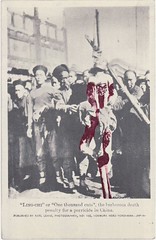Cover of the 1937 guide book to the Degenerate Art Exhibition.
Nazi Germany disapproved of contemporary German art movements such as Expressionism and Dada and on July 19, 1937 it opened the travelling exhibition in the Haus der Kunst in Munich, consisting of modernist artworks chaotically hung and accompanied by text labels deriding the art, to inflame public opinion against modernity and Judaism. The cover the 1937 guide book (illustration top) features a sculpture of unknown origin. It could be Polynesian or any other tribal art work, please help me out here.
The sculpture clearly links modern art with primitivism.
This exhibition is also a perfect illustration of the beneficial side-effects of censorship. Beneficial in the sense that any attempt at banning works of art, books or other cultural artifacts results in an aide to discerning culturati to seek out these artifacts with zeal. Such has been the case with Video Nasties, the Index Librorum Prohibitorum (the Catholic Index) and the Degenerate Art expo mentioned above.
I once again repeat my question to you, dear reader: what is the origin of the statue depicted in the picture above. I thank you beforehand for a reply.






